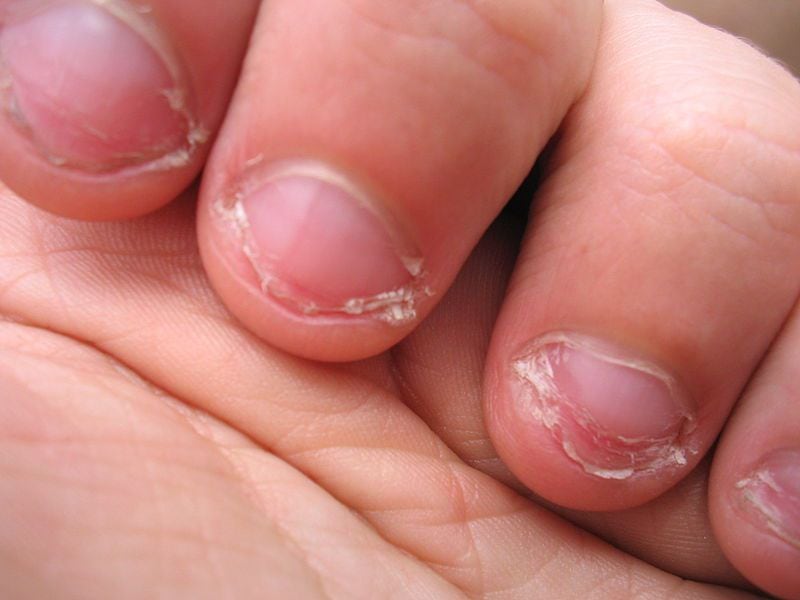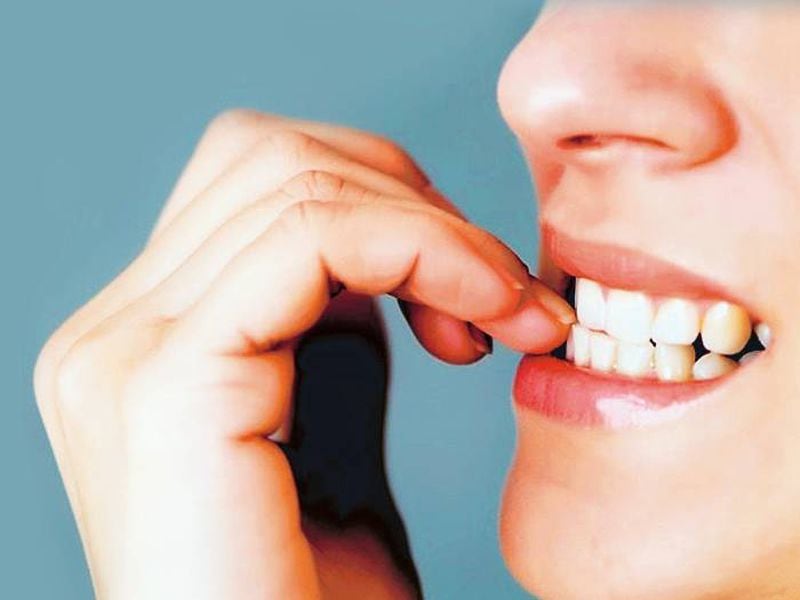10% of adults suffer from nail biting, the name given to this habit which, in addition to being unpleasant and painful, can permanently damage the fingers and is generally the symptom of a deeper problem. Is there a remedy to stop it?
If you clicked on this link, chances are you’re reading with one hand on your cell phone and the other over your mouth, chewing on a fingernail. But calm down: we are not here to judge you. Completely the opposite.
According to Camila Rojas, founder of the salon Nails up! Onychophagia (this is the scientific name for the compulsive act of nail biting) is commonly attributed to a way of dealing with anxiety and stress.
“By biting their nails, people can release tension and experience a temporary sense of relief. Plus, some may even feel like biting their nails helps them focus better on specific tasks, like studying or working,” she explains.
“In general, onychophagia is associated with problems that go beyond a bad habit,” adds psychologist Yasna Amaro. This unconscious gesture, which is difficult to control and repress, is generally a response to reduce emotional tension. “That is to say, it is a mechanism that seeks to reduce anxiety, producing a calming effect. It is important to clarify that this behavior is involuntary, it is not premeditated” .
Most people, of course, want to stop doing this: apart from hurting their fingers, it’s not a very subtle or proper gesture, or very hygienic. Unfortunately, it’s not to reach out and make that decision. “Since it’s a reflex to reduce symptoms of anxiety, anxiety, or stress, and it works as a way to escape difficult situations,” Amaro explains, it’s actually the tip of the iceberg and not the problem itself.
The consequences of biting your nails
For Héctor Fuenzalida, dermatologist at Integramédica, onychophagia is a bad habit, “which can sometimes be associated with a lack of elements such as iron, but which generally responds to an uncontrolled state of anxiety”.
Among the short-term risks, Fuenzalida lists sores in the distal area of the fingers – mainly in the eponychia, commonly known as the cuticle, and in the paronychia, which is the skin on the sides of the nail – and also the loss of part of the fabric.
It is also very common the appearance of nails or skins, which in turn generate painful wounds. “And by constantly moistening the fingertips, bacterial and fungal infections can occur,” warns the dermatologist.

Onychophagia is more common than it seems. Although there are no precise data in Chile, studies conducted in Asia They say 30% of boys and girls between the ages of 7 and 10 have the habit, a figure that rises to 45% by adolescence. In adulthood, yes, the prevalence decreases sharply: in Spain, for example, Only 10% of people over 35 bite their nails. .
Those who maintain this tendency for a good part of their life risk long-term problems: Fuenzalida says that it can even generate a change in the root of the nail, an area that is under the cuticle, a problem capable of deforming this part of the fingers. This is called onychodystrophy or nail dystrophy.
Damage to the nails will vary depending on how hard the person bites them, but if it’s a frequent behavior, Camila Rojas says it will surely weaken them, making them more likely to break and delaying their growth. “Emotionally, it can also be a reason for embarrassment or discomfort in social situations, as the habit notoriously affects the physical appearance of the hands.”
All on deck (and unhooked)
The million dollar question is already known: is there a cure or a solution to stop biting your nails? The answers are varied.
“One of the practical ways to inhibit nail biting is to cover the nail with other materials; for example, any nail extension system, whether acrylic, polygel or gel,” recommends Consuelo Rodríguez, manicurist and podiatrist at Babic Integral Aesthetics .
This will cause us to chew on a harder, more synthetic material instead of biting our nails, which over time can discourage nail biting. The problem? The teeth can be very damaged.
“Another way is to use permanent nail polish, which because it lasts longer, around 14 to 21 days, can distract attention and the desire to bite your nails,” Rodríguez adds. “These work in many cases because they are elements foreign to the natural nail, which interfere with the rapid reach of it. On the other hand, the aesthetic modification diverts from bringing them to the mouth, ”he assures.
In a column for the English newspaper Guardian , the psychologist Elena Touroni affirms that this type of measure contributes to “giving harmful consequences to this habit”, even if to achieve a lasting change over time, the key is to be “proactive”. “Identify what you’re using this habit for – to calm anxiety, stress or anxiety – then find other activities that can replace it,” she says, such as embroidery, using aids to relaxation or even filling in a puzzle.
Héctor Fuenzalida also agrees that these types of products are not the cure, “at least in the dermatological field”. At one time, he says, there were products that were applied to the nails with a bitter or pungent taste: by putting the hands in the mouth, the person felt rejected and avoided doing it. “However, these have been eliminated due to the level of toxicity they could produce if ingested. In this sense, the recommendation will always be focused on seeking psychological help that enables behavior change,” he recommends.
Camila Rojas suggests the same: “Onychophagia can be managed with therapy, with relaxation techniques and other methods to reduce anxiety. If the habit is compulsive or interferes with daily life, it’s important to seek help from a doctor or therapist.”
As a specialist in the field, he has put forward some behavioral guidelines to follow. The first thing, as always, is to recognize the problem and be motivated to change it. “It’s important to identify the triggers of nail biting and then find effective strategies, such as regular exercise or following certain relaxation guidelines.”

While there are many techniques for learning how to put this behavior aside, psychologist Yasna Amaro adds that there is one but to be aware of. “Onychophagia always has a reason behind it,” he says. “If the origin is not attacked, the root symptom, we will only learn to avoid one bad habit and perhaps replace it with another.” Nail biting, as we said, is usually a symptom of an underlying problem.
The recommendation, when the habit is very intense and harmful, is to consult a mental health professional to help identify the situations that cause these conflicts and how I can manage them in a way that is less harmful to our bodies.
“Managing emotions effectively is the first step to letting go of any kind of maladaptive behavior,” says Amaro.
In the meantime, a piece of advice from Camila Rojas is to keep your hands busy. “The person can use an object between their fingers, like a pen or a stress ball, and have it between their fingers. Applying bitter polish to the nails, although not a permanent solution, can help discourage the person from biting them.
“Overcoming this habit can take time and effort, but with persistence and the right strategies, it can be done,” he says. “It takes perseverance and patience to effectively attack nail biting,” adds Consuelo Rodriguez. “After the first month of treatment, the person will see significant changes in their nails.”
Source: Latercera
I am David Jack and I have been working in the news industry for over 10 years. As an experienced journalist, I specialize in covering sports news with a focus on golf. My articles have been published by some of the most respected publications in the world including The New York Times and Sports Illustrated.


